Door FIAT TALENTO 2020 Owner handbook (in English)
[x] Cancel search | Manufacturer: FIAT, Model Year: 2020, Model line: TALENTO, Model: FIAT TALENTO 2020Pages: 236, PDF Size: 4.86 MB
Page 143 of 236
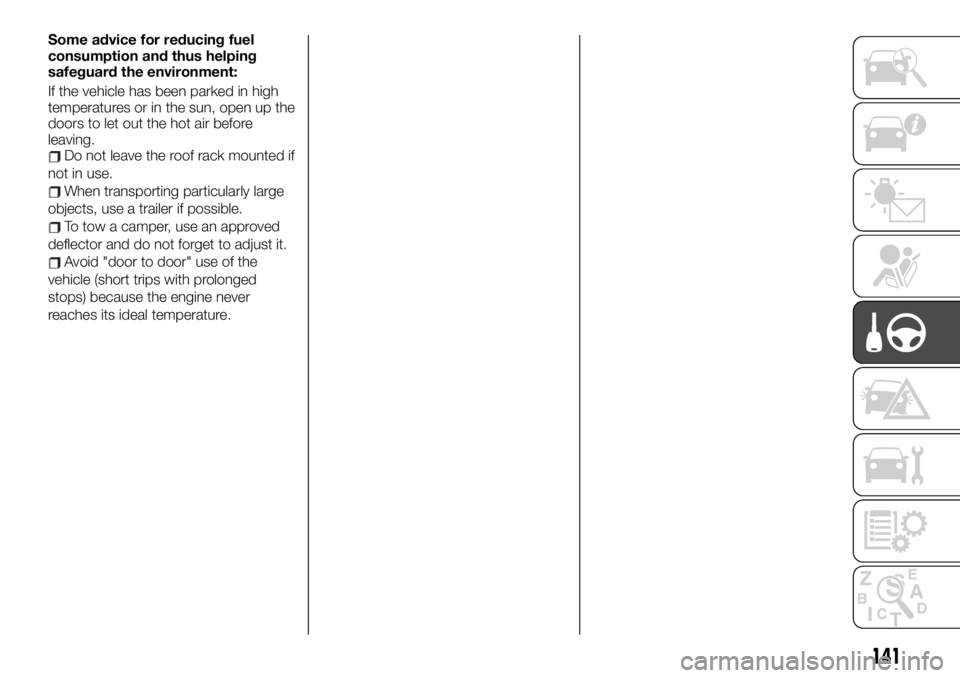
Some advice for reducing fuel
consumption and thus helping
safeguard the environment:
If the vehicle has been parked in high
temperatures or in the sun, open up the
doors to let out the hot air before
leaving.
Do not leave the roof rack mounted if
not in use.
When transporting particularly large
objects, use a trailer if possible.
To tow a camper, use an approved
deflector and do not forget to adjust it.
Avoid "door to door" use of the
vehicle (short trips with prolonged
stops) because the engine never
reaches its ideal temperature.
141
Page 149 of 236
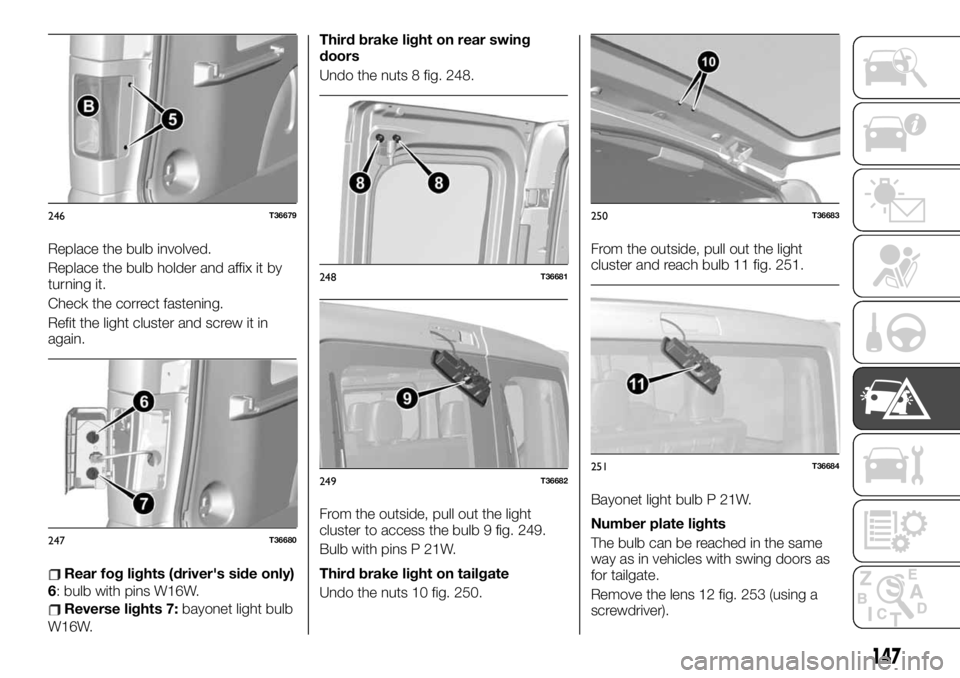
Replace the bulb involved.
Replace the bulb holder and affix it by
turning it.
Check the correct fastening.
Refit the light cluster and screw it in
again.
Rear fog lights (driver's side only)
6: bulb with pins W16W.
Reverse lights 7:bayonet light bulb
W16W.Third brake light on rear swing
doors
Undo the nuts 8 fig. 248.
From the outside, pull out the light
cluster to access the bulb 9 fig. 249.
Bulb with pins P 21W.
Third brake light on tailgate
Undo the nuts 10 fig. 250.From the outside, pull out the light
cluster and reach bulb 11 fig. 251.
Bayonet light bulb P 21W.
Number plate lights
The bulb can be reached in the same
way as in vehicles with swing doors as
for tailgate.
Remove the lens 12 fig. 253 (using a
screwdriver).
246T36679
247T36680
248T36681
249T36682
250T36683
251T36684
147
Page 159 of 236
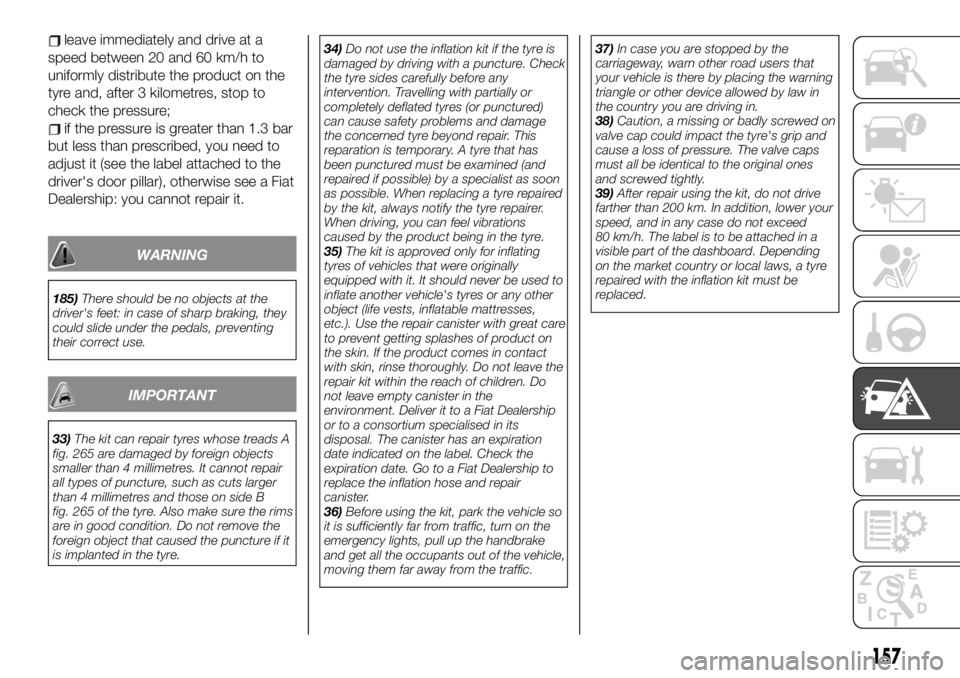
leave immediately and drive at a
speed between 20 and 60 km/h to
uniformly distribute the product on the
tyre and, after 3 kilometres, stop to
check the pressure;
if the pressure is greater than 1.3 bar
but less than prescribed, you need to
adjust it (see the label attached to the
driver's door pillar), otherwise see a Fiat
Dealership: you cannot repair it.
WARNING
185)There should be no objects at the
driver's feet: in case of sharp braking, they
could slide under the pedals, preventing
their correct use.
IMPORTANT
33)The kit can repair tyres whose treads A
fig. 265 are damaged by foreign objects
smaller than 4 millimetres. It cannot repair
all types of puncture, such as cuts larger
than 4 millimetres and those on side B
fig. 265 of the tyre. Also make sure the rims
are in good condition. Do not remove the
foreign object that caused the puncture if it
is implanted in the tyre.34)Do not use the inflation kit if the tyre is
damaged by driving with a puncture. Check
the tyre sides carefully before any
intervention. Travelling with partially or
completely deflated tyres (or punctured)
can cause safety problems and damage
the concerned tyre beyond repair. This
reparation is temporary. A tyre that has
been punctured must be examined (and
repaired if possible) by a specialist as soon
as possible. When replacing a tyre repaired
by the kit, always notify the tyre repairer.
When driving, you can feel vibrations
caused by the product being in the tyre.
35)The kit is approved only for inflating
tyres of vehicles that were originally
equipped with it. It should never be used to
inflate another vehicle's tyres or any other
object (life vests, inflatable mattresses,
etc.). Use the repair canister with great care
to prevent getting splashes of product on
the skin. If the product comes in contact
with skin, rinse thoroughly. Do not leave the
repair kit within the reach of children. Do
not leave empty canister in the
environment. Deliver it to a Fiat Dealership
or to a consortium specialised in its
disposal. The canister has an expiration
date indicated on the label. Check the
expiration date. Go to a Fiat Dealership to
replace the inflation hose and repair
canister.
36)Before using the kit, park the vehicle so
it is sufficiently far from traffic, turn on the
emergency lights, pull up the handbrake
and get all the occupants out of the vehicle,
moving them far away from the traffic.37)In case you are stopped by the
carriageway, warn other road users that
your vehicle is there by placing the warning
triangle or other device allowed by law in
the country you are driving in.
38)Caution, a missing or badly screwed on
valve cap could impact the tyre's grip and
cause a loss of pressure. The valve caps
must all be identical to the original ones
and screwed tightly.
39)After repair using the kit, do not drive
farther than 200 km. In addition, lower your
speed, and in any case do not exceed
80 km/h. The label is to be attached in a
visible part of the dashboard. Depending
on the market country or local laws, a tyre
repaired with the inflation kit must be
replaced.
157
Page 176 of 236
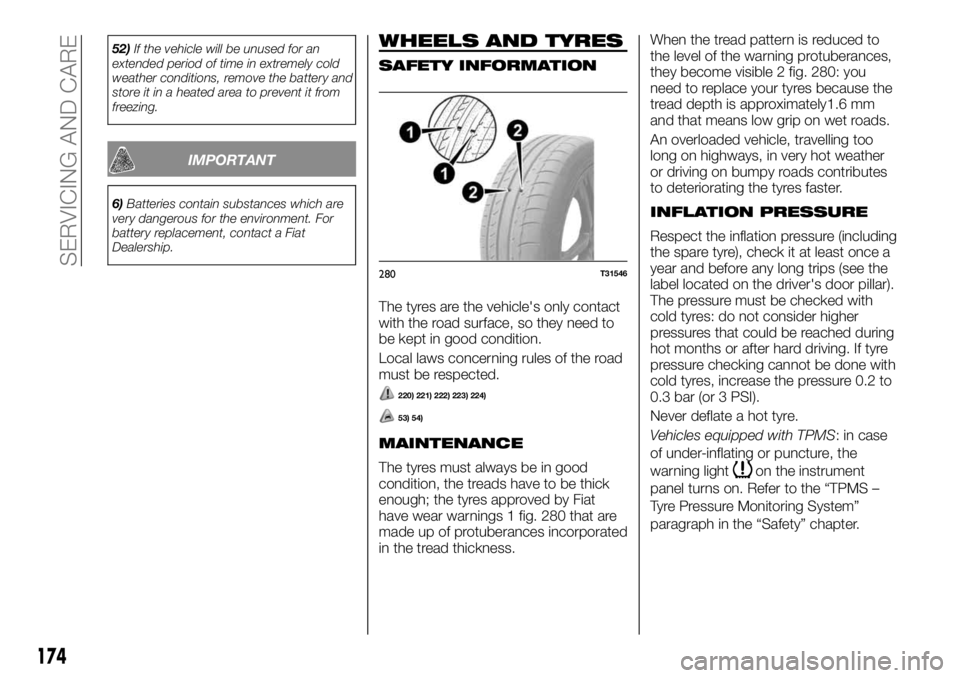
52)If the vehicle will be unused for an
extended period of time in extremely cold
weather conditions, remove the battery and
store it in a heated area to prevent it from
freezing.
IMPORTANT
6)Batteries contain substances which are
very dangerous for the environment. For
battery replacement, contact a Fiat
Dealership.
WHEELS AND TYRES
SAFETY INFORMATION
The tyres are the vehicle's only contact
with the road surface, so they need to
be kept in good condition.
Local laws concerning rules of the road
must be respected.
220) 221) 222) 223) 224)
53) 54)
MAINTENANCE
The tyres must always be in good
condition, the treads have to be thick
enough; the tyres approved by Fiat
have wear warnings 1 fig. 280 that are
made up of protuberances incorporated
in the tread thickness.When the tread pattern is reduced to
the level of the warning protuberances,
they become visible 2 fig. 280: you
need to replace your tyres because the
tread depth is approximately1.6 mm
and that means low grip on wet roads.
An overloaded vehicle, travelling too
long on highways, in very hot weather
or driving on bumpy roads contributes
to deteriorating the tyres faster.
INFLATION PRESSURE
Respect the inflation pressure (including
the spare tyre), check it at least once a
year and before any long trips (see the
label located on the driver's door pillar).
The pressure must be checked with
cold tyres: do not consider higher
pressures that could be reached during
hot months or after hard driving. If tyre
pressure checking cannot be done with
cold tyres, increase the pressure 0.2 to
0.3 bar (or 3 PSI).
Never deflate a hot tyre.
Vehicles equipped with TPMS: in case
of under-inflating or puncture, the
warning light
on the instrument
panel turns on. Refer to the “TPMS –
Tyre Pressure Monitoring System”
paragraph in the “Safety” chapter.
280T31546
174
SERVICING AND CARE
Page 177 of 236
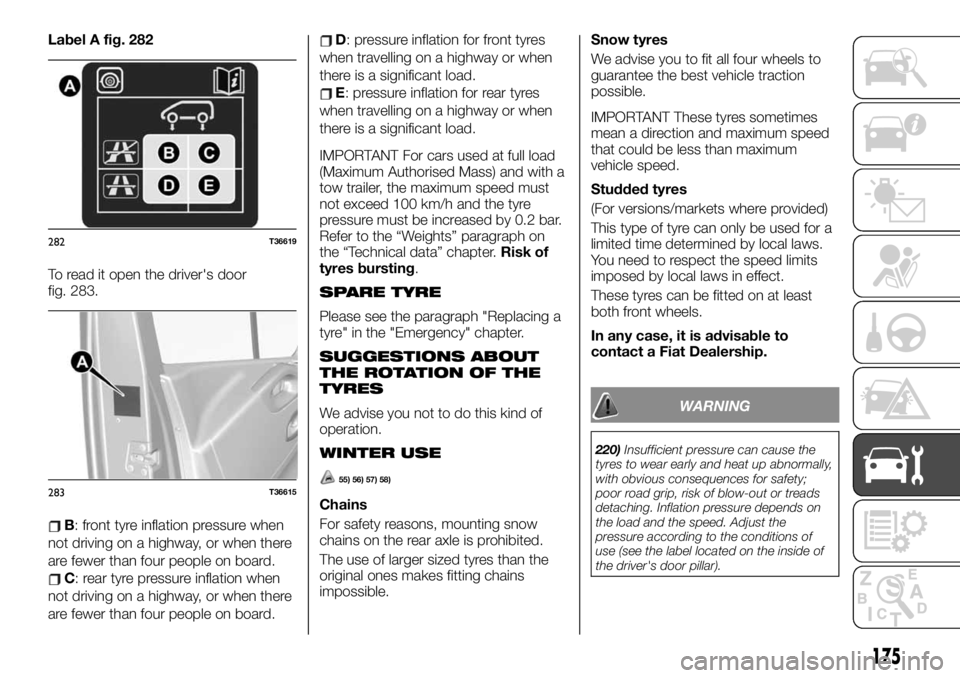
Label A fig. 282
To read it open the driver's door
fig. 283.
B: front tyre inflation pressure when
not driving on a highway, or when there
are fewer than four people on board.
C: rear tyre pressure inflation when
not driving on a highway, or when there
are fewer than four people on board.
D: pressure inflation for front tyres
when travelling on a highway or when
there is a significant load.
E: pressure inflation for rear tyres
when travelling on a highway or when
there is a significant load.
IMPORTANT For cars used at full load
(Maximum Authorised Mass) and with a
tow trailer, the maximum speed must
not exceed 100 km/h and the tyre
pressure must be increased by 0.2 bar.
Refer to the “Weights” paragraph on
the “Technical data” chapter.Risk of
tyres bursting.
SPARE TYRE
Please see the paragraph "Replacing a
tyre" in the "Emergency" chapter.
SUGGESTIONS ABOUT
THE ROTATION OF THE
TYRES
We advise you not to do this kind of
operation.
WINTER USE
55) 56) 57) 58)
Chains
For safety reasons, mounting snow
chains on the rear axle is prohibited.
The use of larger sized tyres than the
original ones makes fitting chains
impossible.Snow tyres
We advise you to fit all four wheels to
guarantee the best vehicle traction
possible.
IMPORTANT These tyres sometimes
mean a direction and maximum speed
that could be less than maximum
vehicle speed.
Studded tyres
(For versions/markets where provided)
This type of tyre can only be used for a
limited time determined by local laws.
You need to respect the speed limits
imposed by local laws in effect.
These tyres can be fitted on at least
both front wheels.
In any case, it is advisable to
contact a Fiat Dealership.
WARNING
220)Insufficient pressure can cause the
tyres to wear early and heat up abnormally,
with obvious consequences for safety;
poor road grip, risk of blow-out or treads
detaching. Inflation pressure depends on
the load and the speed. Adjust the
pressure according to the conditions of
use (see the label located on the inside of
the driver's door pillar).
282T36619
283T36615
175
Page 179 of 236
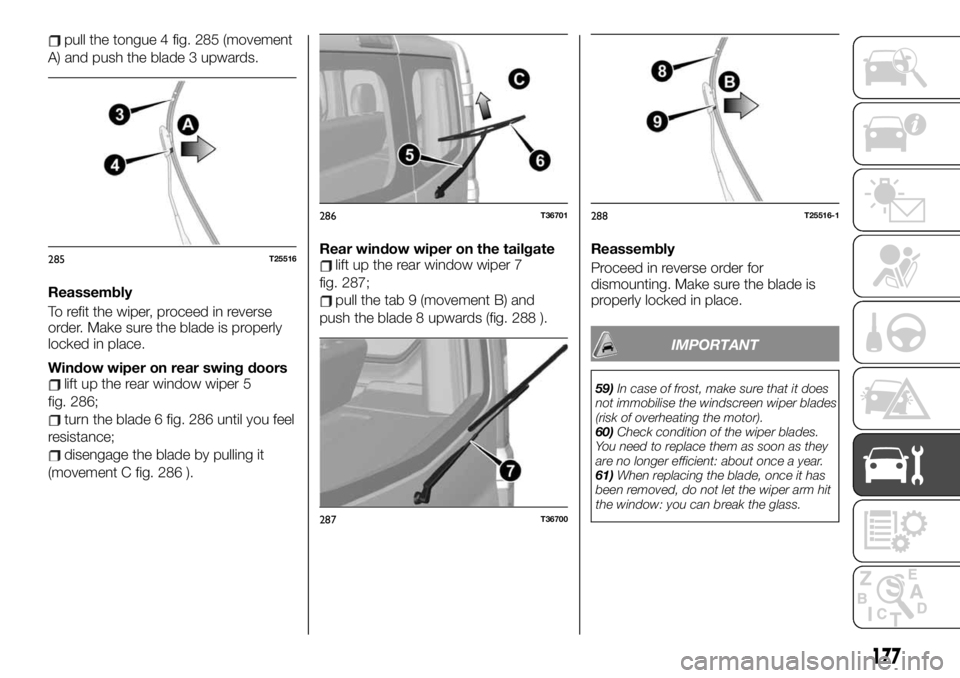
pull the tongue 4 fig. 285 (movement
A) and push the blade 3 upwards.
Reassembly
To refit the wiper, proceed in reverse
order. Make sure the blade is properly
locked in place.
Window wiper on rear swing doors
lift up the rear window wiper 5
fig. 286;
turn the blade 6 fig. 286 until you feel
resistance;
disengage the blade by pulling it
(movement C fig. 286 ).Rear window wiper on the tailgate
lift up the rear window wiper 7
fig. 287;
pull the tab 9 (movement B) and
push the blade 8 upwards (fig. 288 ).Reassembly
Proceed in reverse order for
dismounting. Make sure the blade is
properly locked in place.
IMPORTANT
59)In case of frost, make sure that it does
not immobilise the windscreen wiper blades
(risk of overheating the motor).
60)Check condition of the wiper blades.
You need to replace them as soon as they
are no longer efficient: about once a year.
61)When replacing the blade, once it has
been removed, do not let the wiper arm hit
the window: you can break the glass.
285T25516
286T36701
287T36700
288T25516-1
177
Page 180 of 236
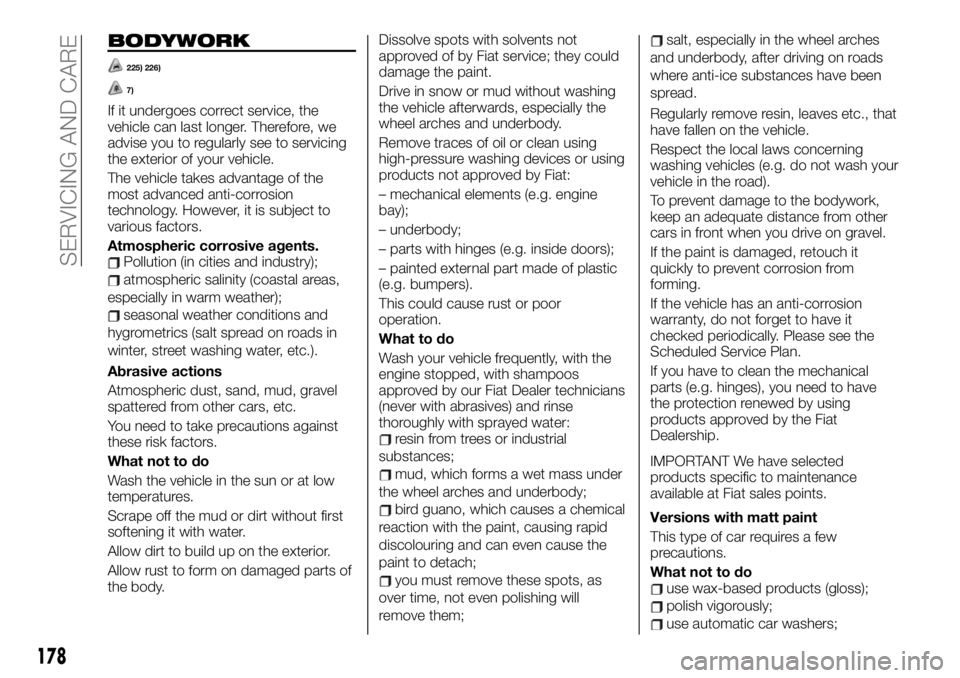
BODYWORK
225) 226)
7)
If it undergoes correct service, the
vehicle can last longer. Therefore, we
advise you to regularly see to servicing
the exterior of your vehicle.
The vehicle takes advantage of the
most advanced anti-corrosion
technology. However, it is subject to
various factors.
Atmospheric corrosive agents.
Pollution (in cities and industry);
atmospheric salinity (coastal areas,
especially in warm weather);
seasonal weather conditions and
hygrometrics (salt spread on roads in
winter, street washing water, etc.).
Abrasive actions
Atmospheric dust, sand, mud, gravel
spattered from other cars, etc.
You need to take precautions against
these risk factors.
What not to do
Wash the vehicle in the sun or at low
temperatures.
Scrape off the mud or dirt without first
softening it with water.
Allow dirt to build up on the exterior.
Allow rust to form on damaged parts of
the body.Dissolve spots with solvents not
approved of by Fiat service; they could
damage the paint.
Drive in snow or mud without washing
the vehicle afterwards, especially the
wheel arches and underbody.
Remove traces of oil or clean using
high-pressure washing devices or using
products not approved by Fiat:
– mechanical elements (e.g. engine
bay);
– underbody;
– parts with hinges (e.g. inside doors);
– painted external part made of plastic
(e.g. bumpers).
This could cause rust or poor
operation.
What to do
Wash your vehicle frequently, with the
engine stopped, with shampoos
approved by our Fiat Dealer technicians
(never with abrasives) and rinse
thoroughly with sprayed water:
resin from trees or industrial
substances;
mud, which forms a wet mass under
the wheel arches and underbody;
bird guano, which causes a chemical
reaction with the paint, causing rapid
discolouring and can even cause the
paint to detach;
you must remove these spots, as
over time, not even polishing will
remove them;
salt, especially in the wheel arches
and underbody, after driving on roads
where anti-ice substances have been
spread.
Regularly remove resin, leaves etc., that
have fallen on the vehicle.
Respect the local laws concerning
washing vehicles (e.g. do not wash your
vehicle in the road).
To prevent damage to the bodywork,
keep an adequate distance from other
cars in front when you drive on gravel.
If the paint is damaged, retouch it
quickly to prevent corrosion from
forming.
If the vehicle has an anti-corrosion
warranty, do not forget to have it
checked periodically. Please see the
Scheduled Service Plan.
If you have to clean the mechanical
parts (e.g. hinges), you need to have
the protection renewed by using
products approved by the Fiat
Dealership.
IMPORTANT We have selected
products specific to maintenance
available at Fiat sales points.
Versions with matt paint
This type of car requires a few
precautions.
What not to do
use wax-based products (gloss);
polish vigorously;
use automatic car washers;
178
SERVICING AND CARE
Page 182 of 236
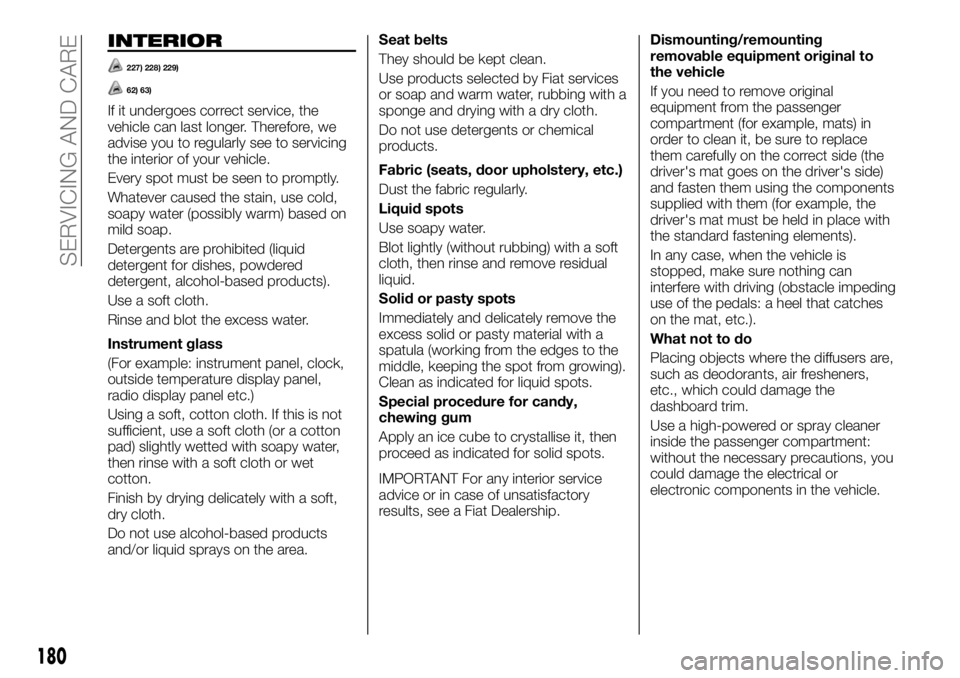
INTERIOR
227) 228) 229)
62) 63)
If it undergoes correct service, the
vehicle can last longer. Therefore, we
advise you to regularly see to servicing
the interior of your vehicle.
Every spot must be seen to promptly.
Whatever caused the stain, use cold,
soapy water (possibly warm) based on
mild soap.
Detergents are prohibited (liquid
detergent for dishes, powdered
detergent, alcohol-based products).
Use a soft cloth.
Rinse and blot the excess water.
Instrument glass
(For example: instrument panel, clock,
outside temperature display panel,
radio display panel etc.)
Using a soft, cotton cloth. If this is not
sufficient, use a soft cloth (or a cotton
pad) slightly wetted with soapy water,
then rinse with a soft cloth or wet
cotton.
Finish by drying delicately with a soft,
dry cloth.
Do not use alcohol-based products
and/or liquid sprays on the area.Seat belts
They should be kept clean.
Use products selected by Fiat services
or soap and warm water, rubbing with a
sponge and drying with a dry cloth.
Do not use detergents or chemical
products.
Fabric (seats, door upholstery, etc.)
Dust the fabric regularly.
Liquid spots
Use soapy water.
Blot lightly (without rubbing) with a soft
cloth, then rinse and remove residual
liquid.
Solid or pasty spots
Immediately and delicately remove the
excess solid or pasty material with a
spatula (working from the edges to the
middle, keeping the spot from growing).
Clean as indicated for liquid spots.
Special procedure for candy,
chewing gum
Apply an ice cube to crystallise it, then
proceed as indicated for solid spots.
IMPORTANT For any interior service
advice or in case of unsatisfactory
results, see a Fiat Dealership.Dismounting/remounting
removable equipment original to
the vehicle
If you need to remove original
equipment from the passenger
compartment (for example, mats) in
order to clean it, be sure to replace
them carefully on the correct side (the
driver's mat goes on the driver's side)
and fasten them using the components
supplied with them (for example, the
driver's mat must be held in place with
the standard fastening elements).
In any case, when the vehicle is
stopped, make sure nothing can
interfere with driving (obstacle impeding
use of the pedals: a heel that catches
on the mat, etc.).
What not to do
Placing objects where the diffusers are,
such as deodorants, air fresheners,
etc., which could damage the
dashboard trim.
Use a high-powered or spray cleaner
inside the passenger compartment:
without the necessary precautions, you
could damage the electrical or
electronic components in the vehicle.
180
SERVICING AND CARE
Page 223 of 236
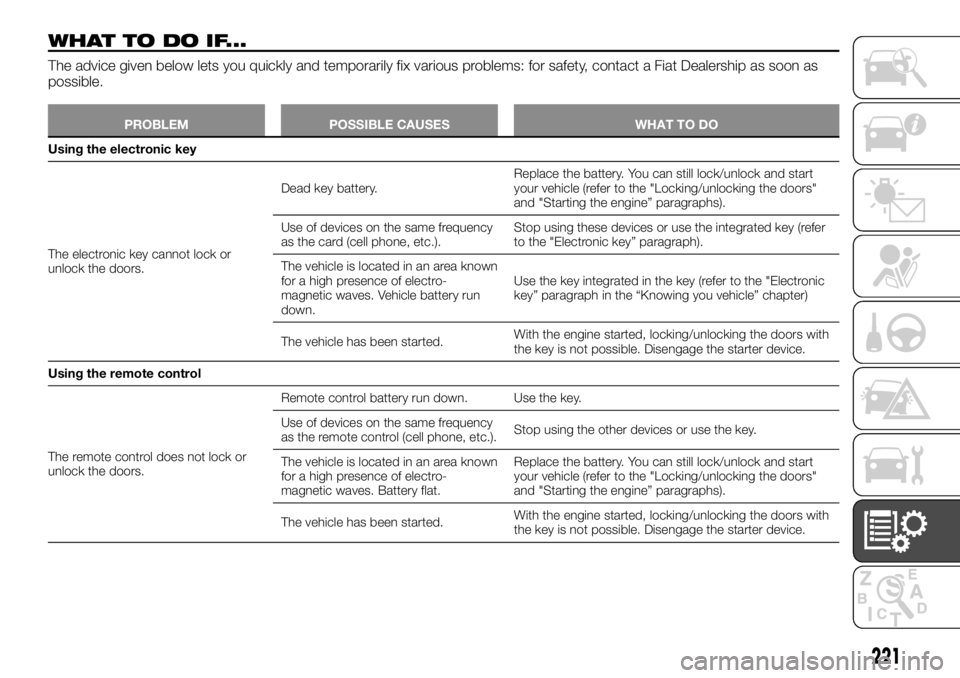
WHATTODOIF...
The advice given below lets you quickly and temporarily fix various problems: for safety, contact a Fiat Dealership as soon as
possible.
PROBLEM POSSIBLE CAUSES WHAT TO DO
Using the electronic key
The electronic
key cannot lock or
unlock the doors.Dead key battery.Replace the battery. You can still lock/unlock and start
your vehicle (refer to the "Locking/unlocking the doors"
and "Starting the engine” paragraphs).
Use of devices on the same frequency
as the card (cell phone, etc.).Stop using these devices or use the integrated key (refer
to the "Electronic key” paragraph).
The vehicle is located in an area known
for a high presence of electro-
magnetic waves. Vehicle battery run
down.Use the key integrated in the key (refer to the "Electronic
key” paragraph in the “Knowing you vehicle” chapter)
The vehicle has been started.With the engine started, locking/unlocking the doors with
the key is not possible. Disengage the starter device.
Using the remote control
The remote control does not lock or
unlock the doors.Remote control battery run down. Use the key.
Use of devices on the same frequency
as the remote control (cell phone, etc.).Stop using the other devices or use the key.
The vehicle is located in an area known
for a high presence of electro-
magnetic waves. Battery flat.Replace the battery. You can still lock/unlock and start
your vehicle (refer to the "Locking/unlocking the doors"
and "Starting the engine” paragraphs).
The vehicle has been started.With the engine started, locking/unlocking the doors with
the key is not possible. Disengage the starter device.
221
Page 233 of 236
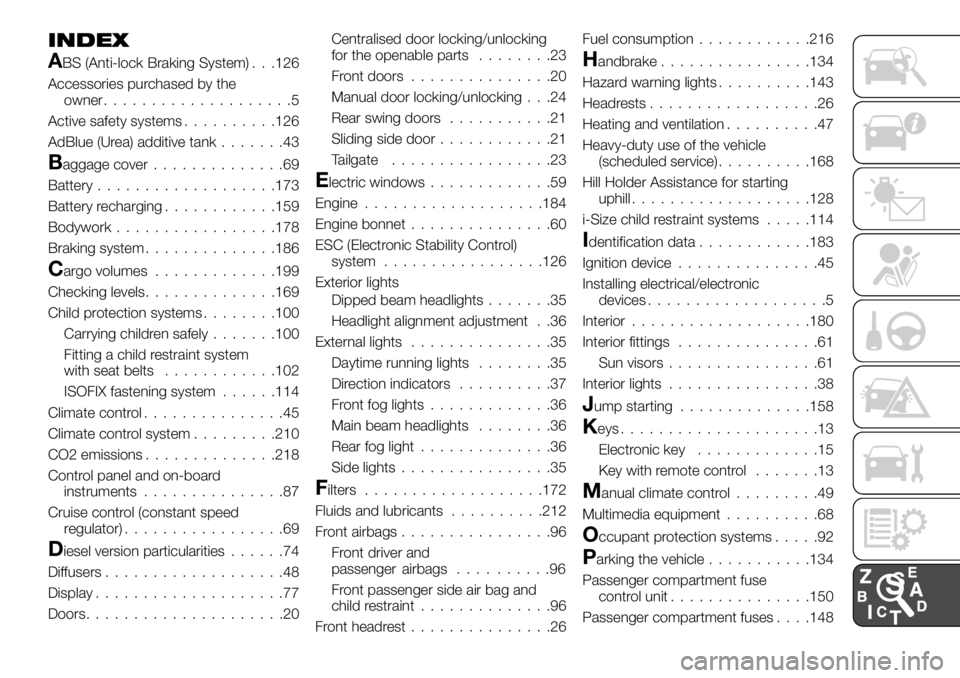
INDEX
ABS (Anti-lock Braking System) . . .126
Accessories purchased by the
owner....................5
Active safety systems..........126
AdBlue (Urea) additive tank.......43
Baggage cover..............69
Battery...................173
Battery recharging............159
Bodywork.................178
Braking system..............186
Cargo volumes.............199
Checking levels..............169
Child protection systems........100
Carrying children safely.......100
Fitting a child restraint system
with seat belts............102
ISOFIX fastening system......114
Climate control...............45
Climate control system.........210
CO2 emissions..............218
Control panel and on-board
instruments...............87
Cruise control (constant speed
regulator).................69
Diesel version particularities......74
Diffusers...................48
Display....................77
Doors.....................20Centralised door locking/unlocking
for the openable parts........23
Front doors...............20
Manual door locking/unlocking . . .24
Rear swing doors...........21
Sliding side door............21
Tailgate.................23
Electric windows.............59
Engine...................184
Engine bonnet...............60
ESC (Electronic Stability Control)
system.................126
Exterior lights
Dipped beam headlights.......35
Headlight alignment adjustment . .36
External lights...............35
Daytime running lights........35
Direction indicators..........37
Front fog lights.............36
Main beam headlights........36
Rear fog light..............36
Side lights................35
Filters...................172
Fluids and lubricants..........212
Front airbags................96
Front driver and
passenger airbags . . . . ......96
Front passenger side air bag and
child restraint..............96
Front headrest...............26Fuel consumption............216
Handbrake................134
Hazard warning lights..........143
Headrests..................26
Heating and ventilation..........47
Heavy-duty use of the vehicle
(scheduled service)..........168
Hill Holder Assistance for starting
uphill...................128
i-Size child restraint systems.....114
Identification data............183
Ignition device...............45
Installing electrical/electronic
devices...................5
Interior...................180
Interior fittings...............61
Sun visors................61
Interior lights................38
Jump starting..............158
Keys.....................13
Electronic key.............15
Key with remote control.......13
Manual climate control.........49
Multimedia equipment..........68
Occupant protection systems.....92
Parking the vehicle...........134
Passenger compartment fuse
control unit...............150
Passenger compartment fuses. . . .148